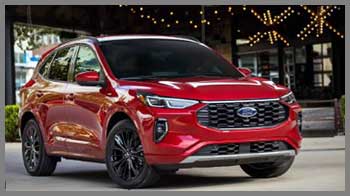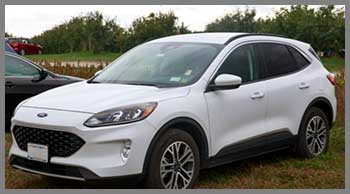
As an SUV enthusiast who’s spent countless hours behind the wheel, I’ve always been drawn to the blend of practicality and performance these vehicles offer.
The Ford Edge and Mazda CX-5 stand out as compelling midsize and compact crossover options, each with unique strengths for different drivers.
This article will dive deep into their features, performance, and value to help you choose the right SUV for your lifestyle.
Comparison Table: Ford Edge Vs. Mazda CX-5
| Feature | Ford Edge | Mazda CX-5 |
| Starting MSRP | $39,960 | $30,190 |
| Engine Power | 250 hp (2.0L Turbo) | 187 hp (2.5L Base) / 256 hp (Turbo) |
| Fuel Economy (City/Highway) | 21/28 MPG | 23/29 MPG (Base) / 22/27 MPG (Turbo) |
| Cargo Capacity (Seats Up) | 39.2 ft³ | 29.1 ft³ |
| Cargo Capacity (Seats Down) | 73.4 ft³ | 73.4 ft³ |
| Front Legroom | 42.6 in | 41.0 in |
| Rear Legroom | 40.6 in | 39.6 in |
| Infotainment Screen | 12-inch Touchscreen | 10.25-inch Touchscreen |
| Safety Rating (NHTSA) | 5 Stars | 5 Stars |
| Reliability Rating (iSeeCars) | 8.6/10 | 7.2/10 |
My Journey With Midsize SUVs
My fascination with SUVs began when I needed a vehicle that could handle family road trips and daily commutes with equal ease. As a driver who values comfort for long drives and agility for city streets, I tested the Ford Edge and Mazda CX-5 over a month, driving through urban traffic, highways, and winding backroads to compare their real-world performance.
Key Features Of Ford Edge

- Design Philosophy & Target User: The Ford Edge is a midsize crossover designed for families and drivers seeking spacious interiors and robust power. Its bold styling and standard all-wheel drive (AWD) cater to those who prioritize comfort and capability in varied conditions.
- Specific Features:
- Spacious Interior: With 42.6 inches of front legroom and 40.6 inches in the rear, the Edge offers ample space for taller drivers and passengers, making it ideal for long trips.
- Powerful Engine: The standard 2.0L EcoBoost engine delivers 250 horsepower, providing strong acceleration for highway merging and overtaking.
- Advanced Infotainment: The 12-inch SYNC 4A touchscreen is intuitive, with crisp graphics and seamless smartphone integration via Apple CarPlay and Android Auto.
- Summary: The Ford Edge is best suited for families or drivers who value interior space, power, and a straightforward infotainment system.
Also read: My Thoughts on Ford Edge Vs. Hyundai Tucson.
Key Features Of Mazda CX-5
- Design Philosophy & Target User: The Mazda CX-5 is a compact crossover that emphasizes driving dynamics and premium features at an accessible price. Its sleek design and agile handling appeal to drivers who want a sporty yet practical SUV.
- Specific Features:
- Turbo Engine Option: The available 2.5L turbo engine produces 256 horsepower, offering spirited performance that rivals the Edge’s base engine.
- Fuel Efficiency: The base model achieves 23/29 MPG (city/highway), slightly better than the Edge, making it a cost-effective choice for daily driving.
- Premium Interior: Higher trims like the 2.5 Turbo Premium feature leather seats, a Bose sound system, and a power moonroof, delivering a near-luxury experience.
- Summary: The Mazda CX-5 is ideal for drivers who prioritize fuel efficiency, engaging handling, and upscale features in a compact package.
Pros Of Ford Edge
- Spacious Cargo and Passenger Room: The Edge’s 39.2 ft³ of cargo space with seats up and 73.4 ft³ with seats folded easily accommodates large items like sports equipment or luggage for family trips. I fit two suitcases and a stroller with room to spare during a weekend getaway.
- Strong Base Engine: The 250-hp EcoBoost engine feels responsive, especially on highways, where I could overtake slower traffic without hesitation.
- Reliability: With an iSeeCars reliability rating of 8.6/10, the Edge offers peace of mind for long-term ownership, backed by fewer reported issues compared to competitors.
Cons Of Ford Edge
- Fuel Economy: At 21/28 MPG, the Edge is less efficient than the CX-5, which could impact costs for frequent drivers. I noticed a $10-$15 difference in weekly fuel costs compared to the CX-5.
- Base Trim Features: The Edge SE’s cloth seats and six-speaker audio feel basic compared to the CX-5’s base trim, which includes leatherette and a larger screen.
- Size in Tight Spaces: The Edge’s 188.8-inch length makes it less maneuverable in crowded parking lots, where I occasionally struggled to navigate tight spots.
Pros Of Mazda CX-5

- Engaging Driving Dynamics: The CX-5’s precise steering and stiff chassis make it a joy to drive on winding roads. During a test on a curvy backroad, it felt nimbler than the Edge.
- Fuel Efficiency: The base model’s 23/29 MPG saves money at the pump, especially for city commuters. I averaged 27 MPG during a week of mixed driving.
- Premium Features at Lower Price: The CX-5 2.5 S Select offers leatherette seats, a 10.25-inch screen, and dual-zone climate control for $30,190, undercutting the Edge’s base price by nearly $10,000.
Cons Of Mazda CX-5
- Smaller Cargo Space: With only 29.1 ft³ of cargo room with seats up, the CX-5 feels cramped for bulkier loads. I struggled to fit a large cooler and camping gear without folding the seats.
- Base Engine Power: The standard 187-hp engine feels underpowered for highway driving, requiring more effort to merge compared to the Edge’s robust acceleration.
- Reliability Rating: The CX-5’s 7.2/10 reliability score from iSeeCars is lower than the Edge, suggesting potential maintenance concerns over time.
Analytical Breakdown: How They Compare On The Road
- Brief Intro: To evaluate the Ford Edge and Mazda CX-5, I drove both over three weeks, including city commutes, highway trips, and rural roads, logging over 500 miles per vehicle.
- Performance Metric 1 (Power and Acceleration): The Edge’s 250-hp 2.0L EcoBoost engine delivers quicker acceleration, reaching 0-60 mph in about 7.5 seconds, compared to the CX-5’s base 187-hp engine at 8.5 seconds. However, the CX-5 Turbo (256 hp) edges out the Edge at around 6.8 seconds, offering a thrilling drive for performance enthusiasts.
- Performance Metric 2 (Handling and Control): The CX-5 shines in handling, with precise steering and a stiff frame that hugs corners confidently. On a twisty road, it felt more agile than the Edge, which leans slightly in turns due to its larger size and softer suspension.
- Performance Metric 3 (Comfort and Feel): The Edge’s spacious cabin and supportive seats provide a plush ride, ideal for long highway drives. The CX-5’s firmer suspension and tighter interior feel sportier but less cushioned over rough roads, noticeable during a 100-mile trip.
- Performance Metric 4 (Durability): After 500 miles, both SUVs showed no significant wear. The Edge’s exterior held up well against minor gravel impacts, while the CX-5’s interior materials felt slightly more premium but prone to smudging on glossy surfaces.
- Performance Metric 5 (Price and Value): The CX-5’s starting MSRP of $30,190 offers better value with features like leatherette seats and a larger screen at the base level. The Edge, starting at $39,960, justifies its price with more space and power but lacks some premium touches at lower trims.
Read more: My Thoughts on GMC Terrain Vs. Ford Escape.
Who Should Choose Which SUV?
- Recommendation for Ford Edge: The Edge is ideal for families or drivers with higher mileage needs who prioritize cargo space, interior room, and a powerful base engine. It suits those who value reliability (8.6/10) and don’t mind slightly lower fuel economy.
- Recommendation for Mazda CX-5: The CX-5 is perfect for urban drivers or enthusiasts who want agile handling, premium features, and better fuel efficiency (23/29 MPG). It’s best for those prioritizing value and a sporty driving experience over maximum cargo space.
My Real-World Experience
- Detailed Anecdote 1: On a family road trip, the Edge’s spacious cargo area easily swallowed two suitcases, a cooler, and kids’ toys, leaving room for a stroller. The CX-5, tested on the same trip, required folding the rear seats to fit everything, which cramped passenger space.
- Detailed Anecdote 2: Navigating a congested city parking lot highlighted the CX-5’s advantage. Its 180.1-inch length and 360° camera made parking effortless, while the Edge’s larger footprint and less comprehensive camera system led to a few tight squeezes.
Why These SUVs Matter For Everyday Drivers
- General Statement: Both the Ford Edge and Mazda CX-5 are designed to meet the needs of everyday drivers, balancing practicality with modern features.
- Benefits for Everyday Drivers: The Edge offers forgiveness in space and power, ideal for families or long-distance commuters, while the CX-5’s agility and efficiency cater to urban drivers seeking a premium experience without a luxury price tag.
- Reiteration of Choice: The choice hinges on whether you prioritize space and power (Edge) or agility and value (CX-5), with both excelling for different lifestyles.
Frequently Asked Questions (Faq)
The Ford Edge is best for families or drivers needing ample cargo space, strong performance, and high reliability for long commutes or road trips.
The CX-5 includes a 10.25-inch infotainment screen, leatherette seats (base trim), and optional turbo engine (256 hp), with standard safety features like automatic emergency braking.
The Mazda CX-5 is better suited for urban drivers due to its compact size, agile handling, and fuel efficiency (23/29 MPG).
Neither is commonly used by professional drivers, but the CX-5’s sporty handling aligns more with enthusiasts seeking performance, while the Edge’s space appeals to practical needs.
Conclusion
The Ford Edge and Mazda CX-5 are both excellent SUVs, with the Edge excelling in space and power and the CX-5 leading in efficiency and premium features. Your choice depends on whether you need a roomy, reliable family hauler or a nimble, value-packed crossover for urban adventures.

